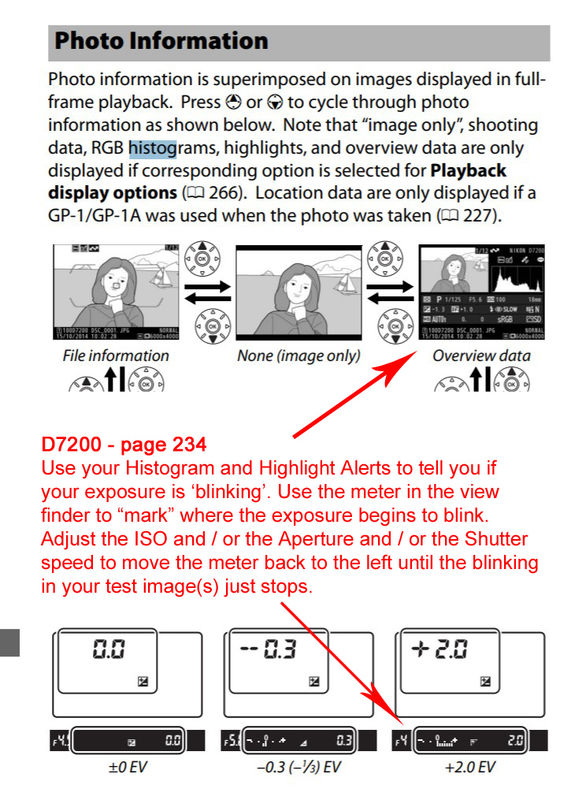Trouble with exposure
Jan 11, 2020 17:21:59 #
I have a Nikon D7200 and I shoot everything in Manual mode. I often find that my exposures are underexposed, especially when I shoot in lower light situations. I don't always go by what the internal light meter says because when I look at the image I have just taken on the back screen, it looks overexposed. Do you think I have the back screen set too bright? Or should I just go by the internal light meter and see what the end results are when I load them into my computer? attached is an example that looked good on the camera screen.
Jan 11, 2020 17:27:04 #
I use the histogram, always, to check the exposure.
(edit)
Do you know how to read a histogram?
(edit)
Do you know how to read a histogram?
Jan 11, 2020 17:28:58 #
bobburk3 wrote:
I have a Nikon D7200 and I shoot everything in Manual mode. I often find that my exposures are underexposed, especially when I shoot in lower light situations. I don't always go by what the internal light meter says because when I look at the image I have just taken on the back screen, it looks overexposed. Do you think I have the back screen set too bright? Or should I just go by the internal light meter and see what the end results are when I load them into my computer?
You should guide by the histograms.
Don't get hung up on that ETTR stuff.
It's not fairy dust, but it's not for every
subject or all users. Try it. Assess how
it informs you of what result you'll get
in PP, and see it it's for you.
I basically draw a mental vertical line
at about the 85% point along the RGB
histogram and I ETTR against the 85%
line [as if it were the 100% end].
Also, I'll compromise the above when
the LEFT side suggests that I should.
If the left is all bunched up, then I'll
sometimes let the chart go past the
85% line. It depends on the scene as
to which end I might compromise.
Jan 11, 2020 17:29:36 #
IDguy
Loc: Idaho
Learn how to use the exposure modes your camera provides.
Also learn how to apply the metering modes.
M is for special cases where you know one of the auto exposure modes won’t work. You seem a long way from that level.
Also learn how to apply the metering modes.
M is for special cases where you know one of the auto exposure modes won’t work. You seem a long way from that level.
Jan 11, 2020 17:33:39 #
Where do you see that the exposures are underexposed?
On the camera LCD only or the computer, or both?
If they are under exposed on the computer, I'd definitely try a few using what the meter recommends and see how they look on the computer. After all, that's what you will be working with, not the camera LCD screen. Then you can adjust the camera screen brightness if necessary.
Also, it depends on the subject and metering method.
For instance, averaging metering for a moon shot with a lot of sky will usually blow out the moon because the camera will "average" a lot of dark with a spot of light.
Edit: What EI values does auto, P, or A mode what to use, compared to what you use in M?
On the camera LCD only or the computer, or both?
If they are under exposed on the computer, I'd definitely try a few using what the meter recommends and see how they look on the computer. After all, that's what you will be working with, not the camera LCD screen. Then you can adjust the camera screen brightness if necessary.
Also, it depends on the subject and metering method.
For instance, averaging metering for a moon shot with a lot of sky will usually blow out the moon because the camera will "average" a lot of dark with a spot of light.
Edit: What EI values does auto, P, or A mode what to use, compared to what you use in M?
Jan 11, 2020 17:49:17 #
IDguy wrote:
Learn how to use the exposure modes your
camera provides.
Also learn how to apply the metering modes.
M is for special cases where you know one
of the auto exposure modes won’t work.
You seem a long way from that level.
camera provides.
Also learn how to apply the metering modes.
M is for special cases where you know one
of the auto exposure modes won’t work.
You seem a long way from that level.
I don't think it's a matter of reaching a "level".
While that approach is general beginner type
method, I very much think OP should stick to
his use of manual metering. Learning all the
modes on the dial is wasteful. Most are just
redundant anywho. There's M, and there's AE.
Having multi versions of AE [A,S,P, iA, etc] is
just clutter. If you sometimes need AE, use it.
Pick one version for EVERY instance of AE use.
They all do the same thing. I happen to prefer
the interface that occurs with P. But some of
my lenses render P as functionally A. No big
deal. Same result.
M-mode, plus one AE-mode. Read histograms.
Enjoy basic photography tools. Get results.
Wash, rinse, repeat.
Jan 11, 2020 17:54:07 #
IDguy wrote:
Learn how to use the exposure modes your camera provides.
Also learn how to apply the metering modes.
M is for special cases where you know one of the auto exposure modes won’t work. You seem a long way from that level.
Also learn how to apply the metering modes.
M is for special cases where you know one of the auto exposure modes won’t work. You seem a long way from that level.
I may not have used the right meter setting, and I will practice the different modes based on your advice, but when I look at the exposure of the image on the back screen of my camera and it looks good, I don't understand why it looks underexposed on my computer.
Jan 11, 2020 17:55:52 #
Longshadow wrote:
Where do yo see that the exposures are underexpose... (show quote)
Looks correct on the camera back screen but is underexposed on my computer.
Jan 11, 2020 17:57:08 #
You can't judge anything useful about the exposure from the LCD display and the perceived "brightness" of the image. Rather, you should be using your histogram and highlight alerts to judge the exposure. When you have "blinking highlight" alerts, look at the meter in the view finder and note the position of the meter. You said you only shoot manual. You should be a quick judge of which parameter to adjust to move the meter to the left in your viewfinder, as well as how much to adjust that parameter. Take another test image and confirm the highlight alerts are resolved or continue to adjust the ISO, Shutter or Aperture. Once you have the desired exposure, make a mental note of the position of the meter. Then, for any subsequent adjustments in the same light, assure the meter is re-positioned to the same offset of the 0-mark to maintain the same exposure. There's no general rule, but you'll tend to find exposures that position the meter greater than +1 to the right of the 0-mark in the view finder will be needed to achieve the blinking highlight warnings.
You can always 'darken' a too bright image in post-processing with a better result than making an underexposed image brighter in post. Your example image includes a lot of 'white' snow. If you want white rather than grey snow, push the exposure until the white blinks as a highlight warning in your test image(s). Then, lower the exposure until the blinking just stops. That's the best way to get "white" whites in your image. Adjust in post as needed, or lower another 1/3 stop for your SOOC result.
You can always 'darken' a too bright image in post-processing with a better result than making an underexposed image brighter in post. Your example image includes a lot of 'white' snow. If you want white rather than grey snow, push the exposure until the white blinks as a highlight warning in your test image(s). Then, lower the exposure until the blinking just stops. That's the best way to get "white" whites in your image. Adjust in post as needed, or lower another 1/3 stop for your SOOC result.
Jan 11, 2020 17:57:28 #
Jan 11, 2020 17:58:50 #
RichardTaylor wrote:
I use the histogram, always, to check the exposure.
(edit)
Do you know how to read a histogram?
(edit)
Do you know how to read a histogram?
Regretably, I have never used the histogram and am unfamiliar with how to use it. I'll read up on it and experiment. Thanks.
Jan 11, 2020 18:16:10 #
CHG_CANON wrote:
You can't judge anything useful about the exposure... (show quote)
This is great information. Thank you so much. Now I have to practice with the histogram.
Jan 11, 2020 18:21:23 #
bobburk3 wrote:
This is great information. Thank you so much. Now I have to practice with the histogram.
For me, the 'graph' that is the histogram is less useful than the blinking highlight alerts that display at the same time. I look where the highlights blink and judge, based on experience / feel, now much of which parameter is needed to lower the exposure to remove those blinking highlights. I can see in the viewfinder as the meter moves to the left along with my adjustments. If not already developed, seek to develop your "finger feel" for each of the controls of ISO, Aperture and Shutter so you can adjust the exposure with the camera raised to the eye looking at the meter in the viewfinder.
When you're one with your camera, that's when the magic begins.

Jan 11, 2020 18:36:22 #
Jan 11, 2020 18:47:25 #
You didn't mention if you shoot raw nor how you edit your photos. It can matter, in terms of how you expose depending on what you are trying to get out of the exposure and how much latitude you have to adjust it later.
If you want to reply, then register here. Registration is free and your account is created instantly, so you can post right away.






